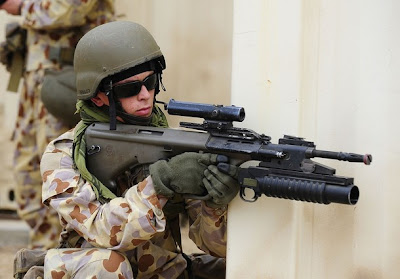The Steyr AUG f88 is also known as the Stg. 77, or the AUG 77. It was designed and built in the late 1960s to replace the FN FAL rifle for the Austrian army. The design was completed in 1977, which is why the number 77 is attached to its title. Although it is not the only bullpup style rifle ever made, it was the first to be introduced to the military of any country as the main arm for troops.
The F88 is a magazine fed, gas blowback (which means some of the expanding gas from when a bullet is shot pushes another bullet into the chamber to be fired) gun. By default, the military version of the AUG has a built in 1.5x scope on the reciever. The F88 has some four interchangeable barrels that can be changed in under a minute if the shooter is aware of what he or she is doing. The AUG has a body made out of a strong polymer plastic, making it light, but durable. In an abuse test, the F88 was run over by tanks, dropped out of airplanes, burried in mud, etc... and the only damage done was to the glass lenses inside of the scope. The barrel of the F88 is threaded to accept silencers, bayonet lugs, grenade launchers and such accessories compatible with the AUG.


Barrel length 508 mm (assault rifle) / 407 mm (carbine)
Accuracy 60 mm at 50m (5 round group)
Integrated optical sight 1.5 magnification
Magazine capacity 30 rounds
Cyclic rate of fire 680 - 850 per minute
Effective range 400 m
Weight (unloaded) 3.6 kg
The Steyr assault rifle is manufactured under licence from Steyr Mannlicher AG by Australain Defence Industries and supplied to the armed forces of Australia and New Zealand as well as other overseas countries. This state-of-the-art weapon is in service in over 30 countries. This military weapon meets today's challenging and unpredictable combat situations with the following features:
5.56mm F88 Austeyr rifle
Very high accuracy
Fully operational in the most severe climates and field conditions for lengthy periods
Easy maintenance under adverse conditions: stripping for field cleaning, maintenance or storage is possible without any tools
Lightweight but delivering heavy fire power: the rifle is made from state-of-the-art materials including high impact glass fibre reinforced polymers
A long service life
Operational in low light conditions
Accepts various aiming devices mounted on a modular Picatinny Rail - such as night firing devices
The Steyr can also be fitted with a 40mm grenade launcher, sling, bayonet, and a blank firing device.
Modification
F88C Austeyr - carbine variant, fitted with a 407 mm barrel and is normally issued to personnel serving with space constraints and weight constraints (e.g. Cavalry, Light Horse and Paratroopers)
F88S-A1 Austeyr - updated version that is issued to front-line combat infantry units. The rifle has the full length 508mm barrel and has a flat top receiver with a long MILSTD 1913 'Picatinny' rail to accommodate specialised optical devices and accessories.
F88S-A1C Austeyr - updated 407 mm barreled carbine variant, with a MILSTD 1913 'Picatinny' rail.
F88S-A2 Austeyr - an evolutionary upgrade of the current rifle to fulfill an operational capability gap. Deliveries of several thousand were completed in late-2009 to selected units for overseas service. Technical improvements in the F88SA2 include: a larger Picatinny Rail on top of the weapon, a modified sight housing, and a side rail mount for a torch and Night Aiming Devices (NAD). The colour of the weapon has also been changed to khaki to reduce the recognition signature.




